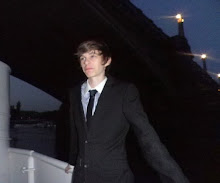Why is Storyboarding an essential part of the film making process?
- It's much easier to communicate your ideas through pictures rather than text or speech.
- It is an important piece of communication between the film crew and provides a base that everyone can work from.
- When filming, the crew must all see the storyboard, so that they know what they are doing, and what needs to be prepared.
- After filming, storyboards act as a reminder of what was filmed and in what order.
- The original storyboard can be compared to the film, to judge the changes.
- The special effects team will be able to see whether or not the directors ideas are possible.
- It allows the director to spot problems before shooting, saving time and money.
- It helps the actors to visualize what they should be doing.
'P' is for 'Psycho'
A.) What is happening in the opening sequence of the film?
The film opens with a low angled shot of a toilet door, with low key lighting. The camera zooms in and it mixes to a low angled shot of a man's legs. The man's body is revealed as the camera tilts up from his legs to show a low angled shot of the man leaning over some kind of surface. It then cuts to a high angled shot of some objects on the surface including: a watch, a photo and a wallet. The camera slowly pans across these objects to allow the audience to take in what they are, suggesting they are important to the rest of the film. It then cuts to a CU of a sink with blood flowing clockwise into the plughole. It then cuts again to a CU of the man wrapping his hand in a bandage before cutting to a CU of the same hand clenching in the mirror. The camera then tilts up to a CU of the man's head. The man quickly turns his head from right to left as we hear the door opening. We are shown a MS of a boy entering the room, (from right to left.) It then cuts back to a MS of the man tucking a gun into his belt, before cutting to an ECU of the man's eyes. The shot is shadowy, and the man says "BAD MOVE KID..." before it fades to black. There is a pause, then we hear two gunshots, making us assume that the man at the sink will be the villain of the film.
B.) How is the narrative flow established?
The narrative is established immediately, with very choppy, to-the-point editing. There is lots of quick cuts between the scenes, and close ups that give hints to the rest of the film. For example the close up of the blood flowing into the sink, hints at some kind of thriller or horror, and creates a suspensory atmosphere. The use of low angled shots and dim lighting make the man seem threatening or scary, and gives an ominous feel to the opening sequence. We get a clear sense of narrative and continuity as the shots all seem to link to one another, and the sequence of events are easily understandable.
C.) If you were directing this sequence, what aspects of the storyboard would you like to change?
If I were directing the sequence, then I would try to create a lot more suspense in order to keep the audience gripped to the film. To do this, rather than having the boy walk into the room straight away, I would have him knock on the door loudly, and the man turn around quickly looking scared. This would create a lot more mystery and ambiguity to the sequence, as the audience would be asking themselves, who knocked at the door? are they good or bad? what is going to happen next? The man would then get his gun out and hide somewhere in the shadows of the toilet. This would be followed be high angled shots of the boy walking into the toilet, maybe whistling "Don't worry, be happy" by Bob Marley. This identifies him as victim and creates sympathy for him as an audience. The sequence would end with a quick cut to black, rather then a fade, as I think a fade would slow the pace. It would finish with two gun shots, as in the original, as i like the mystery behind it.

0 comments:
Post a Comment